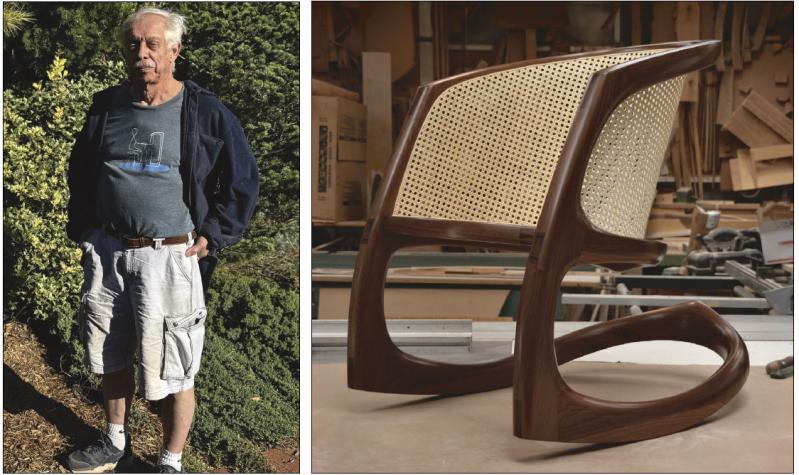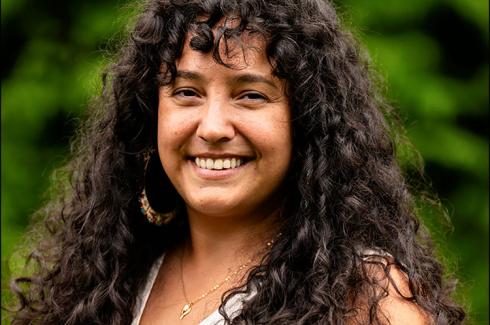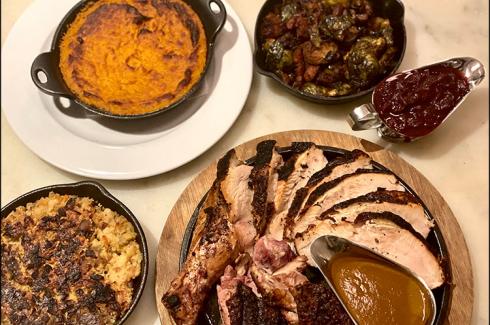“I’ve always been pretty aware of when I start copying myself. That’s when I move on, because it gets too easy,” said David Ebner, an artist, craftsman, and studio furniture-maker whose five-decade body of work is the subject of an exhibition now on view at the Bridgehampton Museum’s Nathaniel Rogers House.
The show, “David Ebner: Five Decades of Original Studio Work Handcrafted on Long Island,” which runs through Oct. 25, occupying almost every room of the museum’s ground floor, showcases the wide range of styles, motifs, and materials that Mr. Ebner has explored over the course of his career. And yet, seeing all the pieces together, certain through-lines become clear: the elegance of his lines, the seamlessness of his joints — the way each piece appears substantial yet almost seems to float.
Mr. Ebner discovered his affinity for woodworking at a young age, in a small workshop his father had set up in the basement of their house in Buffalo. His talent was recognized by his high school woodworking teachers, who let him work in the shop during study halls and on Saturday mornings. He went on to attend the Rochester Institute of Technology’s competitive School for American Craftsmen.
There he studied under Wendell Castle, an influential figure in the “art furniture” movement, and was introduced to the work and philosophy of Wharton Esherick. “His lifestyle inspired me to get into this,” Mr. Ebner said. “I liked the way he worked, how he spent his day, his commitment to design.”
By the time he graduated from the program in 1968, Mr. Ebner estimates, he had spent as much time honing his techniques at his bench in the studio as someone who had been working in his own studio for 10 years. He continued on to a graduate program at the London School of Furniture Design, which he completed before he was drafted by the U.S. Army.
He was assigned to a unit made up of designers, architects, writers, and painters (“all crackerjacks in our field”) based in Alexandria, Va., tasked with creating art exhibitions to promote the Army. He also made presentation boxes for Congressional Medals of Honor, which he would deliver to the Pentagon. “It kept me out of Vietnam,” he said. He left the army in 1971 and traveled around the country, living for a time in Northern California before settling on Long Island (“halfway between East Hampton and Manhattan”), where he set up his first studio.
“I fell into a few different directions,” he recalled. “The early stuff was a little Danish-inspired, a little Chinese-inspired. And what I would do is get the essence of a period, remove all the embellishment, remove all the glitz, and break it down to the really basic principle and design theory. And so that’s how I kind of started.”
“I never copied the style,” he continued. “The minute I started drawing enough, I would just kind of use the themes and the feel and the emotions of those periods, and then use my own vocabulary.” An example is his “cleaning up” Art Nouveau, which began with a feeling that his pieces were feeling “plugged in.”
“I wanted it to be more fluid, like some of the Art Nouveau stuff, but I didn’t want it to look Art Nouveau.” As soon as he started to explore that idea, “a whole series of pieces came along.” Those fluid lines recur throughout the show — in a writing chair, a sofa table, a set of library steps, a half-moon table set against a wall.
“And then I would get into what I called studies — like the sternum bone was a study,” he said. The idea came when he and a friend were eating duck, and he pulled out the bone. “I sat it down, and I watched it rock. And I grabbed my buddy’s, I said, ‘Give me your sternum.’ And I glued the two of them together — that’s this,” he said, gesturing to his sternum bone rocking chair, which is featured in the exhibition.
From that initial concept, the piece became a puzzle that he had to figure out how to engineer. “You’ve got to be so careful that you don’t overwork a design or overembellish it — but you want it to last. I’d really like to see the pieces around for a couple hundred years.” The chair’s first buyer was an engineer from Connecticut. “He looked at it and he goes, ‘That shouldn’t work.’ And I had to explain to him the joinery, and how I reinforce things. He goes, ‘Oh. I’ll take two.’ ”
Also found throughout the exhibition are his “twisted sticks,” branches of maple and sassafras that had been “choked by honeysuckle,” which he would find growing around the edges of wooded areas near his Brookhaven studio and then sand down into smooth forms. “It was a pain in the butt to get,” he said. “There’s poison ivy, there’s wild roses. At one point I had a garageful.” He incorporated some of his last sticks into a pair of lamps, which he finished about four months ago.
Mr. Ebner sees the exhibition (which was made possible by a grant facilitated by Kathryn Curran of the Robert David Lion Gardiner Foundation) as a way of bringing his work full circle. The Bridgehampton gallerist Elaine Benson had become an important champion of his work when she first featured his pieces nearly 50 years ago, just down the street, and he had “a lot of friends in the Hamptons at the time, a lot of good clients.”
“It’s like the last hurrah,” Mr. Ebner said of the show. The business has changed substantially since then, and most of the brick-and-mortar galleries where people used to be able to look at and interact with his work have closed. “It’s always in the back of your head, you know — there’s somebody out there that’s going to want your work.” And so, he said, “let me do one more.”




